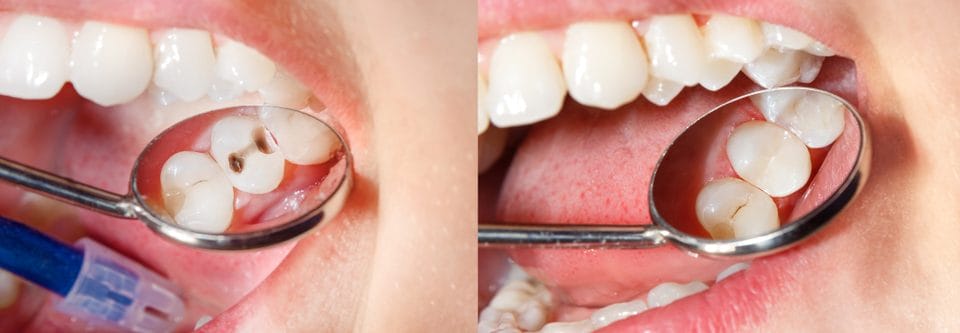
Having a dental emergency? Call us!
614-882-1135
We understand that dental emergencies can happen at any time. If you're in need of urgent care, give us a call, and we'll do everything we can to assist you when it matters most.
Patient Testimonials
Discover Better Dentistry
Become a part of the
Westerville Dental family!
We're accepting new patients. Our dental team prides itself on delivering a truly efficient and enjoyable experience while you’re with us.

Maintaining optimal oral health is essential. Dental fillings can be an important part of fixing decay or damaged teeth. When a tooth is affected, fillings restore its function and appearance. This guide will walk you through the basics and everything you need to know about dental fillings.
Why Dental Fillings Are Essential for Oral Health
Dental fillings are important for keeping your mouth healthy. When a tooth has decay, germs can get past the enamel. This can cause more tooth decay, pain, and even infection. If you don’t treat it, the problem can affect the pulp of the tooth, often leading to a root canal.
Putting in dental fillings on time stops further tooth decay and keeps the tooth structure strong. Fillings also help the tooth work properly, which allows you to chew and bite well. Choosing fillings made from tooth-colored composite resin makes your smile look better while also helping your oral health.
Types of Dental Fillings
Dental fillings come in different materials. The most common filling is a composite resin. They can match the color of your own teeth closely. This makes them look natural. They are great for fixing decayed or damaged teeth, especially in places that people can see.
Dental amalgam, also called silver amalgam, is another material used. This type is strong, lasts a long time, and is affordable. But its shiny, metallic color makes it noticeable, so it’s not the best choice for visible areas in your mouth. There are also other filling options like gold and porcelain.
Composite resin fillings are very popular. People choose them for many reasons. Unlike dental amalgam, these fillings don’t create tooth sensitivity from temperature changes. Composite resin has great thermal insulation. This means it reduces the pain from hot or cold food and drinks.
Diagnosis and Treatment Planning
The first step to getting a dental filling is to have a dental examination. A dentist will look closely at your teeth and use dental X-rays to find any spots of decay or damage. Then, the dentist will check how bad the decay is and where it is located, which will help determine the best treatment options.
The treatment plan will depend on several factors, including the amount of decay, where the tooth is in your mouth, your bite, and what looks good to you.
Tooth Preparation
After the treatment plan is set, the next step is getting the tooth ready for the dental filling. Your dentist will first give you local anesthesia. This helps you stay comfortable during the procedure. The anesthesia numbs the area around the tooth, so you won’t feel any pain.
When the anesthesia kicks in, the dentist removes the decayed or damaged tooth structure with special tools. This important step makes a clean and stable space for the filling material.
Filling Application
With the tooth ready, the next step is to insert the filling material. Dentists usually use hand tools to add this material in layers. They carefully fill the cavity to restore the tooth’s original shape and function.
For amalgam restorations, the material goes into the cavity and is then carefully smoothed out. If composite fillings are used, each layer is applied carefully and has a hardening step called curing. This curing uses a special light, which makes the material firm and strong for a longer time.
Shaping and Polishing
After the filling material dries, your dentist will shape it using tools to ensure it fits your tooth properly. This step helps your bite feel normal and stops any pain when you chew.
Your dentist will polish the filling carefully to make the final restoration look smooth and natural. This process removes any rough spots and flaws. It also prolongs the filling’s life by stopping plaque buildup and staining.
Aftercare and Maintenance
Following your dental filling procedure, adhering to proper aftercare and maintenance protocols is paramount for preserving the integrity and longevity of the filling. By following these guidelines, you can support the healing process and ensure your dental fillings serve you well for years.
Common Concerns and Solutions
Dental fillings are usually safe and work well, but it’s normal to have some worries after getting them. One common worry is tooth pain or sensitivity. This feeling often goes away in a few days to a couple of weeks. To help with discomfort during this time, try using desensitizing toothpaste and avoid very hot or cold foods.
Another concern, though rare, is an allergic reaction to the filling material. If you think you have an allergy, talk to your dentist right away. They might suggest different materials or other treatments to solve the problem.
Schedule a Dental Checkup Today
Dental fillings are very important for keeping your mouth healthy if you experience tooth decay. Knowing the types of fillings, how they are put in, and the care you need afterward is important for them to last a long time. If you have questions about dental fillings, reach out to Westerville Dental Associates today!
Frequently Asked Questions
How long do dental fillings last?
The lifespan of dental fillings depends on the material you choose. Composite material typically lasts around 5 to 10 years. On the other hand, amalgam material can last 15 years or more. Your oral hygiene and chewing habits also affect how long the fillings will last. If you have a healthy tooth structure, it can help your fillings last longer.
Are there any alternatives to traditional fillings?
Yes, depending on the amount of decay and where it is, you can consider different treatments besides regular fillings. Dental inlays and onlays are options that are less invasive than dental crowns. Glass ionomer and composite resin fillings can also be used in certain situations.
How do I know if my filling needs replacement?
Several signs show that you may need a new filling. If you feel tooth sensitivity, see cracks or chips in your filling, or notice a sharp edge, you should schedule a dental care appointment. If there is further decay around the filling site, it is also important to get a dental checkup for a possible replacement.


 Meet Dr. Stickel
Meet Dr. Stickel Meet Dr. Zody
Meet Dr. Zody Meet Dr. Choi
Meet Dr. Choi Meet Dr. Son
Meet Dr. Son


